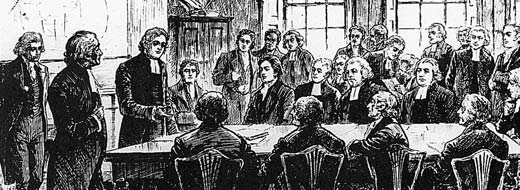By Wayne Kirkland
Twenty-five years ago I had recently embarked on my theology studies – initially by distance, through a couple of North American seminaries.
In one particular course, I wrote a paper which I entitled “The Clapham Sect: A Mission Community”. My first lines were:
Mention the name William Wilberforce to anyone with even the briefest of church history knowledge and they are likely to connect him to the abolition of the slave trade. Mention the name Zachary Macaulay or Granville Sharp to the same person and they are likely to reply, ‘Who?’ Yet there is a very important connection to all three of these men. They were all part of a select group of men and women known as the ‘Clapham Sect’.
My basic thesis was that while William Wilberforce carried the highest profile of any of the group, Clapham was essentially a team of highly committed and energetic people who drew on each other to bring change well beyond their size and influence. A community engaged in mission together.
When the phrase “Clapham Sect” is used, it’s actually quite misleading. It’s a label that was only applied years later. The truth is that they were neither a “sect” nor did they even have a “membership”. The Claphamites were a rather organic and fluid group who counted themselves as orthodox, committed evangelical Anglicans with a passion for “Christianity in action”. And while the village of Clapham contained a core group of people intentionally “doing life” together – particularly the Thorntons, Wilberforces, Grants, Venns, Sharps and Macaulays – there were many others living elsewhere who were intimately involved in the mission of the group. Men and women such as Charles Simeon, Hannah More, Thomas Clarkson, Thomas Gisborne, Thomas Babbington, and Isaac Milner.
The Clapham community was actually the brainchild of a wealthy banker, Henry Thornton, who lived with his family in Clapham – in those days a small village just outside London. Thornton dreamed of developing an evangelical community and he made it possible for a number of houses to be built close to his own mansion. Thornton also pushed to have a young evangelical, John Venn, appointed as the rector of the local Anglican parish.
From the 1790’s onwards, Clapham became a vibrant centre of community, with families living out of each other’s homes, daily prayers, and collaborative projects developed over the kitchen table and in Thornton’s library. In today’s terminology they might be described as a missional community.
In my essay I noted several themes of the life and mission of the Claphamites. Even though we live in a completely different age and circumstances, there’s alot we can learn from them.
Their mission
While the abolition of the slave trade and slavery campaigns were at the heart of their mission, the Clapham community spearheaded numerous other ventures, including initiating campaigns for penal reform, the abolition of the press gang, relief of chimney boys, education for everyone, and the regulation of factory conditions. They also fought to promote the Sabbath, stop indecent literature, abolish the lottery, and put an end to the cruel animal sports of the day.
Then there was their work abroad. They spearheaded the establishment of a colony in West Africa for freed slaves (Sierra Leone), and actively pushed for missionary involvement in India, as well as providing a counteracting force to the commercial pursuits of the British East India Company.
Claphamites were also instrumental in the establishment of the CMS (Church Missionary Society), the British and Foreign Bible Society, the Sunday School movement, and the SPCA (Society for Prevention of Cruelty to Animals).
This extraordinary diversity of initiatives revealed a relatively well-rounded understanding of God’s mission. Certainly the Claphamites saw no dichotomy between evangelism and social justice.
Their strategy
Amongst the Clapham community were several politicians. Their work was to prove critical in their agitation for change. “The Saints” (as they were often referred to in Parliament) were not aligned to any particular party, nor did they ever hold ministerial roles. Nevertheless, they wielded significant influence, even though they numbered just a handful of sitting MP’s at any one time. Free of the need to toe party lines, the Saints argued their causes and built strong alliances with key politicians such as Pitt, Fox and Grenville. In particular, Wilberforce was a master communicator – though the power of his oratory was substantially enhanced by the considerable research provided by men such as Macaulay and Clarkson.
However, the work of Clapham stretched well beyond the political realm. They understood that the education and mobilization of the public was a very powerful force for change – even though political power was still dominated by the wealthy.
Petitions, literature, public meetings, and even an organized boycott of slave-grown sugar, were all used to great effect. In particular, they quickly learnt the power of the written word. They produced pamphlets, books, a periodical and tracts that were cheap and easy to read. Hannah More proved especially masterful in the art of tract writing. Each year millions of pieces of literature were sold – targeting not just the aristocracy, but also the middle and working classes.
Clapham also capitalized on the growing trend of establishing charitable “voluntary societies” to promote their causes. This was genius – for it provided a way for large numbers of the public to get involved – both as volunteers and as financial contributors. Wilberforce was himself a member of 69 voluntary societies and has been compared to “a Prime Minister of a cabinet of philanthropists”! [1]
The point is, the Claphamites learnt how to engage, involve, and mobilise large numbers of people in their causes.
Their synergy
One of my disappointments with the otherwise excellent movie, “Amazing Grace”, was its failure to communicate just how much of a team effort the campaign against the slave trade was.
For William Wilberforce was simply the key mouthpiece for Clapham, and for the wider consortium of interests campaigning against the slave trade and slavery. In fact, as one historian (Ernest Howse) has noted, “Wilberforce needed the others to make him what he was; but the others needed Wilberforce to make a river from a group of pools.” [2]
When I think of Clapham, my mind immediately turns to the word “synergy” – several individuals cooperating with each other in a cause that is way bigger than any of them could tackle. Each person bringing their particular gifts to the table so the end result is far greater than the sum of each of the individual parts. This was Clapham in a nutshell.
And while some of their impact could be attributed to the disproportionate influence people of wealth and class were able to wield in eighteenth and nineteenth century England, a lot of it happened because a group of highly gifted and well-placed men and women were prepared to submit their own agendas and ambitions to the causes Clapham took up. Politicians, lawyers, clergy, writers, bankers, researchers, activists, and public servants – all working collaboratively in highly effective teamwork. The Body of Christ in action. Koinonia in living technicolour.
Their legacy
In my book, Just Money, I suggest that Clapham, “…were leaders in inspiring their society to new values – values that persisted for a century and more, in Great Britain and far beyond its shores.”
In spite of the bad press “Victorian England” and its morality gets these days, there is little doubt in my mind that nineteenth century Britain was a far more just and compassionate society than it would otherwise have been, because of the energy and vision of evangelicals such as the Claphamites. And this influence spilled over into the way Britain went about building its colonial empire.
Of course, like all of us, Wilberforce and co were captive to their times. They have been accused (among other things) of supporting the status quo – particularly in their opposition to trade unions and wider democratic reform – and of working more for the poor than with the poor.. Even so, as Howse points out, “It is useless to criticize them by the standards of twentieth century socialism. They were part of an aristocratic society that had never thought of questioning the order which made some men rich and powerful and others poor and dependent.” [3]
An even more obvious legacy of Clapham’s influence was it’s own progeny. It can be quite confusing tracking who’s who in the Clapham “family tree”. This is partly due to the tendency of children to be named after their parents, grandparents, or friends. Then there’s the intermarriage!
However, when you untangle all this you discover a whole myriad of creative and influential men and women (though not all of whom shared their forbears’ evangelical commitments).. Here’s just a few:
- Samuel Wilberforce – Bishop of Oxford and chief protaganist with Thomas Huxley in the 1860 Oxford evolution debate. Son of William and Barbara Wilberforce.
- Thomas Babington Macaulay – cabinet minister, poet and one of England’s finest historians. Son of Zachary and Selina Macaulay.
- John Venn – philosopher/logician and creator of the Venn diagram. Grandson of Rev John Venn.
- Virginia Woolf – novelist and poet. Great grand-daughter of James Stephen.
The Kiwi connection
And speaking of legacy, one final note of interest is the substantial impact the Clapham community had on our own early NZ history. There are all kinds of interesting connections here. [4]
The establishment of NZ as a British colony, and the associated development of a treaty between the Crown and Maori, occurred under the direction of the British Colonial Office, headed at the time by Sir James Stephen, the under-secretary of state for the colonies (1836-1847). Stephen was the son of one of the Saints. In fact, his father (James Stephen) was the chief architect of the Slave Trade Act, which finally abolished the slave trade in 1807. Like his dad, Sir James was a trained lawyer, and wrote the Slavery Abolition Act, which was passed by Parliament in 1833. In his role as under-secretary he was passionate about charting a new way of relating to indigenous peoples – one that recognized their rights and looked to develop a mutually beneficial partnership.
Interestingly, Stephen’s wife, Jane, also grew up in the Clapham community. She was the daughter of John Venn, the rector of the church at Clapham. And Sir James’ step-mum was the sister of William Wilberforce!
Sir James was the driving force in the Colonial Office’s policy at the time, and was sometimes referred to derisively as “Mr Over-secretary Stephen” or “King Stephen” because of the influence he carried as a senior civil servant.
However, he was far from alone in his influence in shaping government policy. The Cabinet minister in charge of the Colonial Office between 1835 and 1839 was Lord Glenelg, otherwise known as Charles Grant – also the son of a Claphamite! And there were others who were also part of the “humanitarian” group that dominated the Office at the time. They were real irritants to the likes of Edward Gibbon Wakefield (The NZ Company), who had big plans for making money out of the colonization of NZ.
Lord Normanby (successor to Lord Glenelg) wrote an extensive brief to Capt. William Hobson (who penned the Treaty). Stephen’s fingerprints can be seen all over it. Take this paragraph, as an example:
All dealings with the natives for their lands must be conducted on the same principles of sincerity, justice, and good faith as must govern your transactions with them for the recognition of Her Majesty’s sovereignty in the Islands. Nor is that all: they must not be permitted to enter into any contracts in which they might be the ignorant and unintentional authors of injuries to themselves. You will not, for example, purchase from them any territory the retention of which by them be essential or highly conducive to their own comfort, safety, or subsistence. The acquisition of land by the Crown for the future settlement of British subjects must be confined to such districts as the natives can alienate without distress or serious inconvenience to themselves. To secure the observance of this – will be one of the first duties of their Official Protector. [5]
If only succeeding British and NZ officials had honoured these commitments! [6]
But the Clapham-NZ connection does not stop with the Colonial Office. As already noted, the Claphamites were significantly responsible for the establishment of the Church Missionary Society (CMS) in 1799. In fact, Wilberforce was asked to be the first President, but declined, and Thornton was it’s first Treasurer. And, in one of those delightful bits of trivia that reinforce how generational the Sect’s influence was, Henry Venn (son of John Venn) was the leader of the CMS from 1841 to 1873.
The CMS had a huge influence in preparing the way for a treaty with Maori. Students of NZ history will be very familiar with the names Samuel Marsden, Henry and Marianne Williams, William and Jane Williams, and Octavius Hadfield. These men and women were all CMS missionaries, sent to NZ to work with Maori. They learned the language, translated the Bible, and gained the respect and trust of many chiefs. They acted as advocates for Maori, as well as encouraging them to sign a treaty (covenant) they believed would give them protection from the more corrosive elements of European contact and settlement.
So our own heritage (both as Christians and as New Zealanders) is tied to Clapham. For their legacy to us, we owe them a debt of gratitude.
[1] See Robin Furneaux, William Wilberforce.
[2] Ernest Howse, Saints in Politics.
[3] Ibid.
[4] Peter McKenzie has written a very good article on this.. See his “Public Christianity and Te Tiriti o Waitangi: how the ‘Clapham Sect’ reached down under” at http://www..petermckenzie.co.nz/docs/public_christianity.pdf
Originally published in Stimulus (Nov, 2010).
Mark Grace has also written on this connection – see his guest post on the Xenos blogsite – http://xenos-theology.blogspot.co.nz/2010/03/treaty-and-gospel-guest-post-by-mark.html and his recent article in TSCF’s Canvas (Summer, 2014) called “The Gospel & the Treaty of Waitangi”.
[5] “Hobson’s Brief from the Colonial Office” http://www.treatyofwaitangi.net.nz/LordNormanbysBrief.html
[6] In the mid to late 1840’s the influence of the humanitarians began to decline and was replaced by a much less sympathetic view of indigenous rights.
Wayne Kirkland is married to Jill and they live in Upper Hutt, New Zealand. They have three adult daughters. In previous lives Wayne has been a youth worker, part-time car dealer and writer and administrator for Signpost Communications. Wayne is the author and co-author of several books, including “Light from a Dark Star”, “Where’s God on Monday?”, “Soul Purpose” and “Just Decisions”.
Read more of Wayne’s ruminations on his website










0 Comments